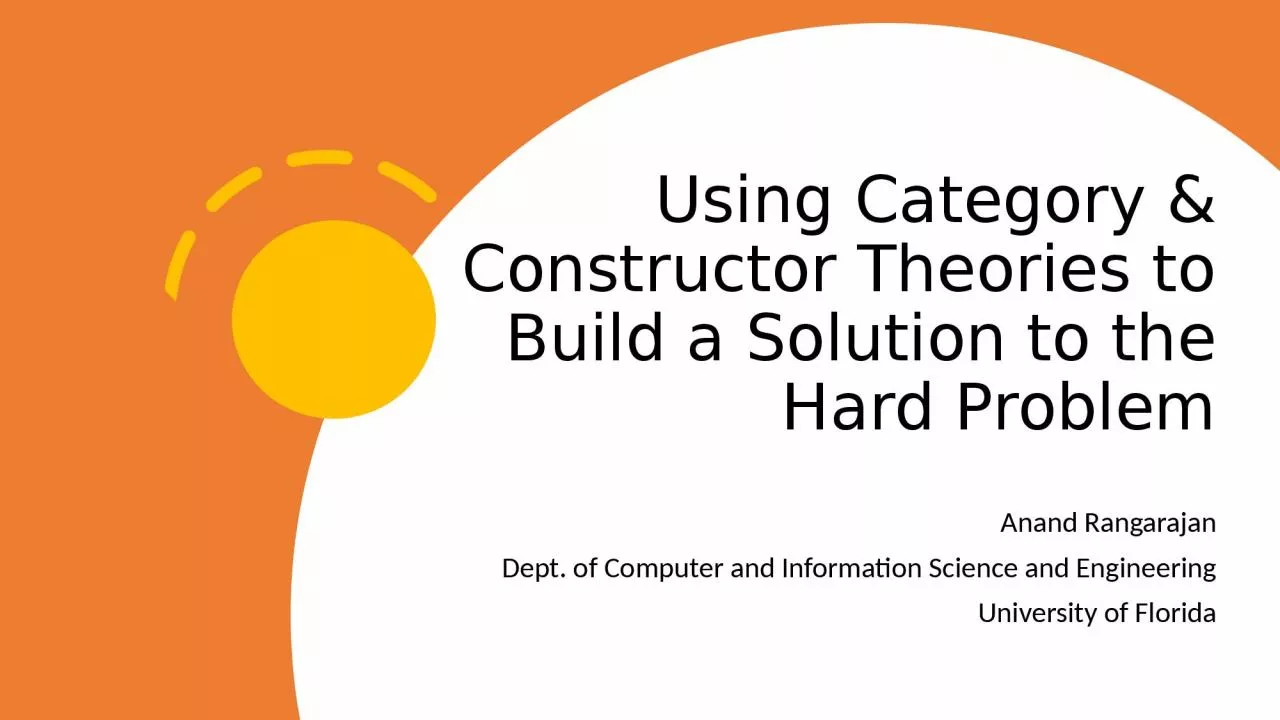

Anand Rangarajan Dept of Computer and Information Science and Engineering University of Florida The Hard Problem Why is anything accompanied by experience Chalmers Structure and dynamics Information processing ID: 1003184
Download Presentation The PPT/PDF document "Using Category & Constructor Theorie..." is the property of its rightful owner. Permission is granted to download and print the materials on this web site for personal, non-commercial use only, and to display it on your personal computer provided you do not modify the materials and that you retain all copyright notices contained in the materials. By downloading content from our website, you accept the terms of this agreement.
1. Using Category & Constructor Theories to Build a Solution to the Hard ProblemAnand RangarajanDept. of Computer and Information Science and EngineeringUniversity of Florida
2. The Hard ProblemWhy is anything accompanied by experience (Chalmers)?Structure and dynamicsInformation processingNeuronal dynamicsPhysicalism and MaterialismMainstream response: EmergenceAlternativesPanpsychism (Rosenberg, Skrbina, Strawson)Dual aspect Theory (Atmanspacher)Neutral Monism (Banks)Idealism (Kastrup)Russellian Monism (Stoljar)Self-organizationComplexitySystems theoryConfused with holism
3. Systems versus ParticlesOur slogan: Complex AI systems are not accompanied by experienceAge old distinction: systems versus particles (back to 19th century atomism)Systems: Capable of complex information processingParticles: Highly unified and spatiotemporally boundedSystems: Wrong way of thinking about consciousnessIntuition: Connection between radically unified experience and particles?Strawson’s subjects of experience suggestive
4. Subjects of Experience, the Physical and SelfonsSoE more akin to a particle than a system (crazy hypothesis)Natural rather than artifactual or culturalBid goodbye to the 19th century: Particles are formed in quantum field theory (QFT) via second quantizationSoEs are special “selfons” accompanied by experience (Rangarajan)Second quantization in QFT creates particles from basic fieldsBut second quantization is a functor (as in category theory pointed out by Edward Nelson)!Can we model SoEs (or selfons) using category theory?Generalize from QM, QFT and move to modeling using category theory
5. Category Theory: BasicsDefinition: A category has constituents:Objects: A collection , elements called objectsMorphisms: For every pair a set of morphisms from to Identity: For every object an identity morphism on Composition: For every three objects , if , and then Intuition: Morphisms are the glue relating objectsComposition formula: Transitivity in object relationsRelevance to HP: Selfons as objects (accompanied by experience) and intersubjectivity as evidence of morphisms
6. Selfons as a CategorySelfons as objects in a categoryMorphisms map subjects onto each otherIntersubjectivity as the grounding intuitionComposition: If and , then Set up a physical category Functors and need not be “inverses.” Selfons may impose further constraints in configuration space (Rosenberg)Importance of configuration space highlights tie to QFT and role of possibilities and not actualities
7. Constructor TheoryVery little coverage in TSC series of conferencesMove away from trajectories, initial conditions and dynamical lawsFormulate physics based on what is possible and what is impossible in specific tasksDavid Deutsch: pioneer of this approachChiara Marletto: a leading figure in present day constructor theory
8. Relevance to Consciousness StudiesPrinciples:All laws expressible entirely in terms of statements about which physical transformations are possible and which are impossible and why.State of the combined system such that any construction undergone by in cannot change state of Linearity in QM emerges from principles like theseWith laws expressed in terms of possibilities, construction of Russellian monism becomes a story of constraints on sets of possibilitiesSpace, time, particles, fields, energy all derived concepts not fundamental. Close affinity with Russellian monism
9. Categories need not be equivalentFunctors can exist between non-equivalent categoriesBrainsSubjects of ExperienceFunctor from the physical to the category of brain statesFunctor from the physical to selfonsEquivalent categoriesNon-equivalent categoriesInformation processing in brains:a convenient shorthandSelfons can enact constraints restricting sets of possibilitiesNatural fit: phase space dynamicsNatural fit: configuration spaceModel: Lagrangian dynamicsModel: Constructor Theory
10. ReferencesDual-aspect Monism à la Pauli and Jung, Harald Atmanspacher, J. Conscious Studies, 19(9-10):96-120, 2012.The Conscious Mind: In Search of a Fundamental Theory, David J. Chalmers, Oxford University Press, 1996.The Constructor Theory of Information, David Deutsch and Chiara Marletto, arXiv:1405.5563 [quant-ph]The Structure of Objects, Kathrin Koslicki, Oxford University Press, 2008.The Ultimate Constituents of the Material World: In Search of an Ontology for Fundamental Physics, Meinard Kuhlmann, Ontos Verlag, 2010Natural Kinds and Conceptual Change, Joseph LaPorte, Cambridge University Press, 2004.Subjects of Experience, Edward J. Lowe, Cambridge University Press, 1996.Can a Quantum Field Theory Ontology help resolve the Problem of Consciousness, Anand Rangarajan, Quantum Reality and Theory of Śūnya, Springer Nature, pp. 13-26, 2019.A Place For Consciousness: Probing the Deep Structure of the Natural World, Gregg Rosenberg, Oxford Univ. Press, 2004.Quantum Field Theory and the Standard Model, Matthew D. Schwartz, Cambridge Univ. Press, 2013Category Theory for the Sciences, David I. Spivak, The MIT Press, 2014.Ignorance and Imagination: The Epistemic Origin of the Problem of Consciousness, Daniel Stoljar, Oxford University Press, 2006.Physicalism, Daniel Stoljar, Routledge, 2010.Selves: An Essay in Revisionary Metaphysics, Galen Strawson, Clarendon Press, 2009.Material Beings, Peter van Inwagen, Cornell University Press, 1990.
11. Contact information:Prof. Anand RangarajanDepartment of Computer and Information Science and EngineeringUniversity of FloridaE-mail: anandr@ufl.edu